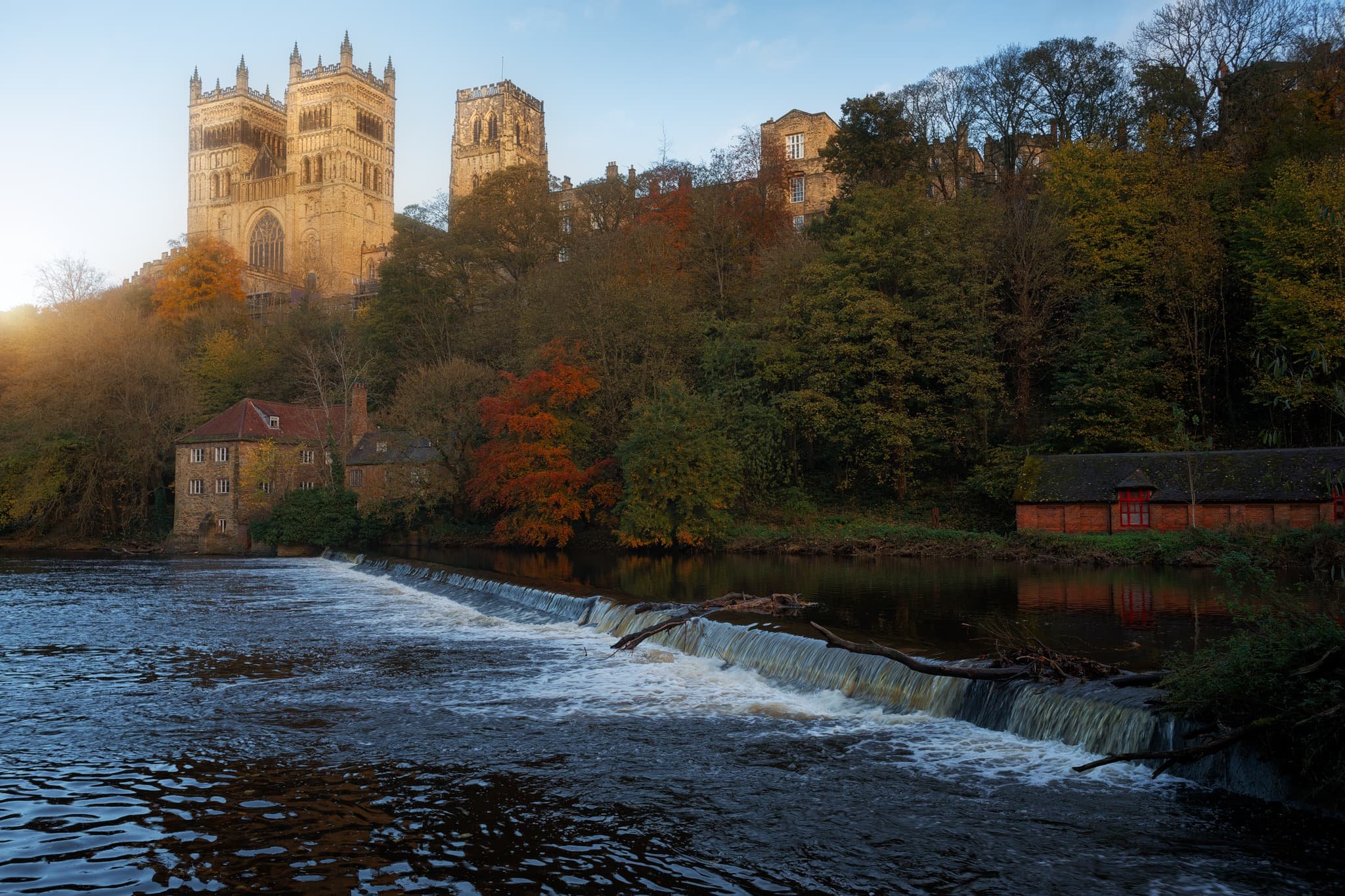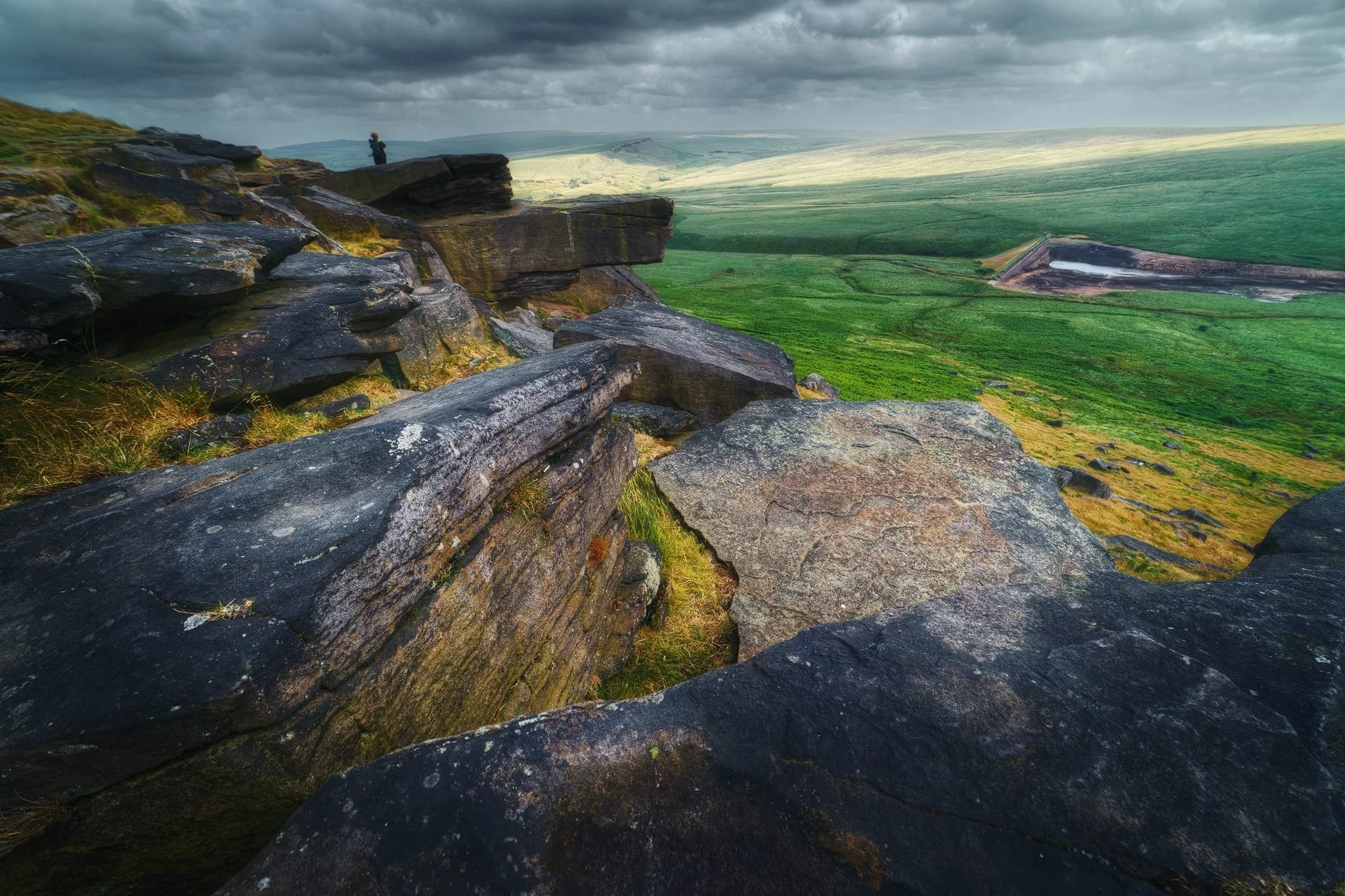Durham, County Durham, Autumn
My first time in Durham.
My first time in Durham.
On the day of our anniversary proper, we woke up nice and early for a full day exploring the historical city of Durham.
I’d never visited the city before. Durham didn’t let me down. The day was bright and clear, bouncing golden light off Durham’s architecture, both modern and ancient.
Though our itinerary was kinda loose, a definite desire was to explore the epic Durham Cathedral, part of a UNESCO World Heritage site with Durham Castle.
Though our day was unfortunately cut short as I unexpectedly developed a stomach bug, what we did manage to see inspired to visit again.
All photos taken on my Sony α7ii using my Pentax SMC 28mm F3.5 and Rokinon 14mm f2.8 ED AS IF UMC prime lenses. RAWs were developed in Lightroom using Cobalt Image’s Sony profiles, with extra help from Photoshop and Photomatix.
Durham, County Durham, Autumn by Ian Cylkowski is licensed under CC BY-NC-SA 4.0
A weir at the River Wear. Clear and low autumnal light makes Durham’s buildings glow gold.
I moved into the shadows on Saddler Street, so I could pick out my compositions where the golden autumnal light was landing in interesting places. Saddler Street is one of Durham’s older roads, originally called Saddlergate.
Branching off Saddler Street is Elvet Bridge. There are numerous little “vennels”, or alleyways, that branch off Elvet Bridge. This was, Drury Lane, was home to a particularly picturesque cafe that we stopped for a brew at. I had to record this ridiculously timeless scene.
Soon we headed towards our main destination of the day: the massive Durham Cathedral, standing tall since the 11th century.
You enter the cathedral first via the Galilee Chapel. Constructed in 1170 CE, this part of the cathedral now serves as the resting place of St. Bede. Saint Bede (673-735) was an English monk and scholar renowned for his work Historia ecclesiastica gentis Anglorum, which provides invaluable insight into the history of Britain and the spread of Christianity among the Anglo-Saxon tribes.
After sorting out our entrance, we paid for the tower climb. Here you can ascend all 325 steps, 218 ft, to enjoy some immense views over Durham. I felt like a drone taking these photos! This is the view looking east.
The other side of the Central Tower gave us more extensive views looking west, pops of autumn colour here and there.
The nave of the cathedral, with its central ribbed vault obscured by the lighting fixtures assembled for an upcoming light show. The nave wouldn’t have looked much different compared to 900 years ago, except their wouldn’t be any seating.
Home to the Cathedra, the choir stalls, the organ, and the high altar, the Quire is where daily worship takes place.
This is the South Transept, from where you would access the Central Tower and climb its 325 steps. It features the Prior’s clock, constructed by Prior Castell in the late 15th or early 16th century.
The High Altar in the Quire. This would’ve been one of the earliest parts of cathedral to be constructed. Monks in the 11th century were seeking a place to hide from Vikings raids as they carried the relics of Saint Cuthbert.
The Chapel of the Nine Altars, built in the 13th century to accommodate the increasing number of pilgrims visiting the cathedral. Since St. Cuthbert’s shrine was seated here, Durham Cathedral has been an important place of worship for Christian pilgrims for centuries.
The Bishop’s Throne, built by Bishop Thomas Hatfield in the 14th century, with his tomb below it.
The light and stained glass windows around the Chapel of the Nine Altars was just astounding.
From around the Cloister, made more famous in modern times as one of the filming sets in the Harry Potter movies.
This is the Monks’ Dormitory, completed around 1404, and nowadays is home to the Cathedral Library, part of Durham Cathedral Museum. This was originally built as sleeping quarters for the Durham Priory monks.
The museum was truly fascinating and, much like the Faith Museum in Bishop Auckland, contained artefacts of faith and religious importance in the area from beyond Roman Times. This place lead to the Great Kitchen, which now houses a sacred part of the museum: Saint Cuthbert’s treasures and coffin.
Kingsgate Footbridge, completely resplendent in autumn colours. Our next goal was to locate the riverside footpath and take a wander along the river bend.
University boat racing was alive and well on the river as the sun began to set.
The woodland deep in the gorge was filled to the brim with incredible autumn colours.
From Prebends Bridge, the boat racing was in full flow, surrounded by vivid autumn foliage.
Putting Prebends Bridge in context of the river, the setting sun bursting from just above the trees.
And finally, Durham Cathedral from the riverside, catching the last of the light and glowing bright.
Did you enjoy these photos?
Marsden, West Yorkshire, Summer
Time for somewhere a little different.
Time for somewhere a little different.
We’re as guilty as anyone of succumbing to the familiar. Conscious of this, Lisabet and I booked a long weekend somewhere we’d never explored before: the moors of West Yorkshire.
Our “base” for the weekend was the bonny village of Marsden. Much like the rest of West Yorkshire, Marsden was an important mill town known for the production of woollen cloth. The days of hard labour in mills, warehouses, and factories are over, but those grand old buildings remain. These days, Marsden is a vibrant and forward-looking place that enjoys a great food and drink scene, easy travel to Manchester or Leeds, and quick access to the beautiful moorland hills that surround it.
The weather wasn’t as kind to us on this particular break, with persistent and at times heavy rain following us for most of the weekend. We attempted a hike up a well-known local hill, Pule Hill, but quickly turned back as it became clear that the various trails up the hill would be too boggy for us.
Instead, we explored the gorgeous scenery around the Huddersfield Narrow Canal, and possibly the windiest shoot I’ve ever done at Buckstones Edge.
All photos taken on my Sony α7ii using my Sony FE 28–70mm f3.5–5.6 OSS zoom, Vivitar “Series 1” 70–210mm f2.8–4.0 zoom, and Rokinon 14mm f2.8 ED AS IF UMC prime lenses. RAWs converted in Lightroom, developed in Photomatix, and edited and finalised in Photoshop.
Marsden, West Yorkshire, Summer by Ian Cylkowski is licensed under CC BY-NC-SA 4.0
On a small clearing above the canal, we captured an inkling of a view of Marsden and its old buildings and mills.
The Huddersfield Narrow Canal between Marsden and Slaithwaite features plenty of picturesque locks in lovely scenery. The canal itself, though only 20 miles long, has 74 locks.
The canal truly is narrow in name and nature. Near Standedge Tunnel, a splash of colour amongst the brickwork catches my eye.
Many sections of Huddersfield Narrow Canal are beautifully lush and verdant.
This is where Huddersfield Narrow Canal enters Standedge Tunnel, carrying watercraft through and underneath the Pennines. At 5.2 km long, 194 m underground, and 196 m above sea level, Standedge Canal Tunnel is Britain’s longest, deepest, and highest canal tunnel.
Our ultimate destination was Pule Hill above the tunnel, at 434 m/1,434 ft above sea level. Though ultimately we retreated from climbing the summit, we nevertheless got fantastic views of Marsden and the valley it sits in.
An old farm cottage that’s seen better days, but nevertheless enjoys fantastic views.
After clambering and squelching back down the valley into Marsden—and refuelling our bellies—we head up to Buckstone Edge. This rim of the valley above March Haigh Reservoir is lined with Millstone Grit crags and boulders that offer a photographer’s paradise of compositions.
At 1,400 ft above sea level, the wind was blowing a raging storm. Probably one of the windiest shoots I’ve ever done. I wanted to capture that sense of rushing and movement everywhere, contrasted against the still and stubborn boulders and crags.
As a result of the high winds, the clouds above us were rushing across the sky. This allowed for the sun to intermittently paint golden streaks of light across the land. All I had to do was watch, wait, and shoot.
I gingerly clambered down the steep valley side, seeking compositions of the Buckstones pointing towards Pule Hill in the distance.
Some of these Millstone Grit boulders were as big as a car, stubbornly resisting the sheer force of the day’s wind.
After satiating my need for ultra-wide compositions, I equipped my 70–210mm lens for some tighter images. Trying to get a steady shot at 210mm with the wind wrestling my camera was definitely a challenge. Some how, I managed a few sharp images!
Pule Hill, which defeated us earlier in the day. Here, at 210mm, it caught the sun’s fleeting paintbrush as I pressed the shutter.
Beyond the village, I spy the distant hills of Marsden Moor receiving their share of the sun’s brief artistic spurt, and set up a composition at 210mm with the Buckstones.
Did you enjoy these photos?
Arnside, Cumbria, Summer
I hope everyone had a lovely Summer Solstice.
I hope everyone had a lovely Summer Solstice.
When it comes to nature and the Summer Solstice, Lisabet and I are fortunate to have a variety of options on our doorstep. With a clear and cloudless evening ahead we decided on the expansive views offered at Arnside.
Arnside is a proper bonny seaside village located on the banks of the Kent Estuary, which eventually spills out into Morecambe Bay. Arnside features a ½ km long viaduct that carries trains across the estuary, and Arnside Tower; a peel tower, built in the 14th/15th century. Another curiosity is the Arnside Bore, a very fast rising tidal bore that occurs most high tides. People often watch the bore from the shoreline, marvelling at the faster-than-walking speed of the tide as Morecambe Bay refills the Kent Estuary every high tide.
For our evening, we just took a gentle meandering stroll along the shoreline of Arnside, enjoying the light and scenes as the sun set on the longest day of the year.
All photos taken on my Sony α7ii using my Sony FE 28–70mm f3.5–5.6 OSS zoom and Rokinon 14mm f2.8 ED AS IF UMC prime lenses. RAWs were developed in Lightroom, processed in Photomatix, and finalised in Photoshop.
Arnside, Cumbria, Summer by Ian Cylkowski is licensed under CC BY-NC-SA 4.0
The gentle curves of the Arnside shoreline catches the golden sunset light, serving as a leading line towards the Arnside Viaduct and the distant Lake District fells beyond.
Probably my favourite shot of the evening. A small channel in the sand provides a nice leading line towards the sunset as onlookers from the pier enjoying the solstice.
Beached buoys provide a nice foreground subject as the sun gently sinks behind the fells.
A tighter composition focusing on this tidal channel as it reflects the fiery sunset light.
Back on the road, I equip my ultra-wide for this composition in the dying light of the day.




